New Zealand Mountain Bike Trail Design & Construction Guidelines





















Mountain biking has quickly become a mainstream sport, with a broad range of bike trails being developed around New Zealand.
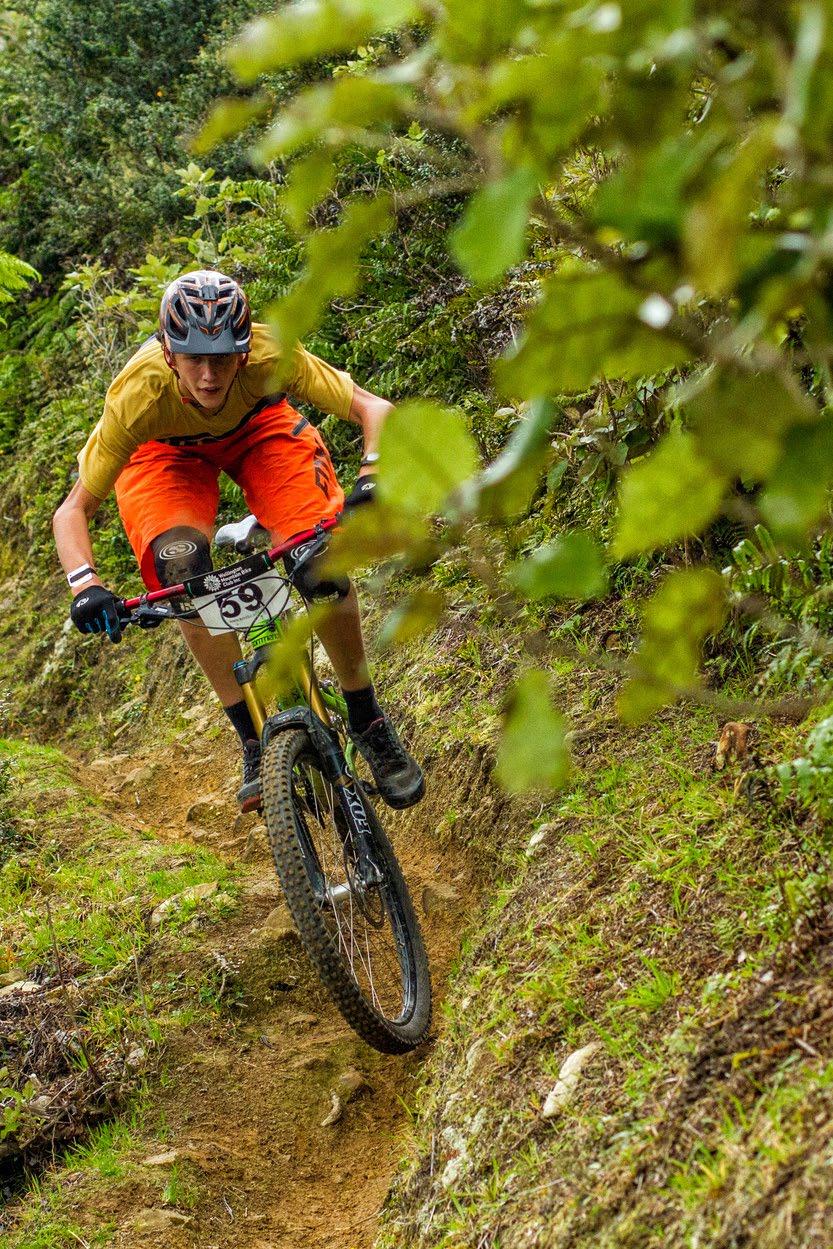
Projects are now being driven by land managers such as the Department of Conservation (DOC), iwi, local and regional councils, and private landowners. Thus adding a more structured and professional approach to complement the wellestablished volunteer based, club driven structure.
Often the project manager or engineer managing the project has no background in the sport, and the volunteer driver may be light on the steps needed to produce a fit for purpose product.
This updated guideline is intended to help all parties develop and clarify their understanding of the creative elements that go into delivering a fun trail experience at each of the six grades of difficulty.
This guideline gives a detailed and defined specification for new trails at each grade. It also provides a template for the maintenance and auditing of existing trails. Any organisation involved with developing, building, maintaining, or auditing a trail is encouraged to use these guidelines - with the overriding goal for NZ to have a level of consistency and continuity around trail grading to ensure a fantastic user experience.
Updated August 2022

Target Audience Suitable for all ages and most fitness levels.The trail feels safe to ride and is ideal as a first ride for non-cyclists, and those wanting an easy gradient or experience. They shall be well-formed, flat, wide, and smooth. The trail allows for cyclists to ride two abreast most of the time and provides a social component to the ride. Cyclists will be able to ride the total distance of the trail without dismounting for obstacles.
Riders develop balance and gear choice skills. Trail shall be wellformed, smooth, with some gentle climbs, is predictable with no surprises, and is suitable for beginner riders. Trail has a social aspect with riders able to ride side by side at times but majority of the trail provides for a single rider. Suitable for most ages and fitness levels.
Riders develop controlled braking skills, and gain riding experience. These trails can be narrow with some hills to climb. There may also be some exposure to dropoffs. Rider needs the skills to ride narrower tracks and maintain balance on a narrower surface and steer to avoid or ride over obstacles.
Riders develop accurate line choice, controlling braking on the edge of traction and gain further riding experience. Obstacles increase in size and frequency, track width varies. Some backcountry trails may also be two-way at this grade.
Riders develop skills to control a bike in sections of trail where there is poor or no traction. Grade 5 trails are technically challenging with big hills, often lots of rocks and some walking likely. Grade 5 trails may traverse a wide range of terrain and cater for riders with generally high levels of skill and experience. Easier “B” Lines should be provided around un-roll-able obstacles.
Trails at this grade should be oneway.
Riders develop supreme bike and tyre placement accuracy. Trail may not be passable in wet weather conditions. These trails include those purposely built downhill / free ride trails for technically advanced and highly experienced riders. Grade 6 trails may traverse a wide range of terrain with large jumps and obstacles catering for extreme riders.
Trails at this grade should be one-way.
Two-way width Regular passing bays, and or/wider sections of trail should be incorporated to assist two-way trail flow
Guidance
One-way trails only
• As sideslope on down hillside of the track increases, the potential of a fall from height increases. Allow extra width where side slopes are steepest and reference the requirements for guardrails/barriers where necessary (table1).
• Tread outslope of 1-5°should be utilised where possible, except for insloped corners and where insloped water table drains are needed for boggy ground(fig 1).
• The cut batter or backslope should not be vertical (unless it is solid rock), but be blended at a minimum of 60°or less, as soil material and site conditions require(fig 1). Note vertical height restrictions for compliance/consent.
• Some sections of trails at Grade 4 and above may not actually be formed and the actual width be discernible in rooty or rocky areas.
User Experience
Riders desire to experience a consistent climb at whatever grade is stated. Riders also desire an interesting experience while climbing, with the opportunity for views and staging areas where available and good use of natural features and trail design to enhance the adventure. If two-way, riders desire a safe and fun experience with good sight lines and visibility, with the opportunity to safely pass and interact with other trail users
desired.
Exceptions (Out of grade tolerance)

A and B combined plus the length of out of spec corners and trail width shall not exceed 2% of the track length
A and B combined plus the length of out of spec corners and trail width shall not exceed 5% of the track length.
Guidance
A and B combined plus the length of out of spec corners and trail width shall not exceed 10% of the track length.
A and B combined shall not exceed 20% of the track length.
Trail gradient, corner radius and width should be reasonably consistent. Where gradient, corner radius, and width are out of specification, they should be no more than one grade harder than the trail's target grade.
• Average Gradient for the whole trail should include grade reversals and all shortchanges in elevation. However, if an Uphill (or Two-way)trail has a significant downhill section or sections, the elevation drop from those sections should be excluded from the Average Gradient calculation.
• Any steep uphill sections of trail are best to occur before or after a flat section or grade reversal- not at the end of a long section at maximum gradient.
• Trail average gradients of 5.7°(1 in 10) are most sustainable. Trail gradients steeper than this are physically unsustainable, will erode quickly and require a high level of armouring and maintenance to keep to grade.
• Maximum sustainable trail gradients may need to be less than stated based on a number of environmental factors(see table 3).
• Grade reversals are recommended at intervals relative to the gradient and soil type of the trail; spacing between reversals should decrease as gradient increases (see table 2 and figures 3 and 4). A grade reversal should occur at every unbridged water crossing point. Deeper grade reversals last longer before silting up.

User Experience Riders desire to experience fun, descending trails that include playful features such as bank wall rides, side hits, enhanced grade reversal dips and rollers, higher bermed corners etc. These trail features, when combined with natural scenery and views create iconic ride experiences.
Turn Radius to outside of tread 6m ± 1m Minimum 4m, 5m minimum desirable Minimum 2.5m, desirable minimum 3m or more if it is a fast trail.
Technical Trail
Features i.e. jumps and vertically stepped drops (Table 6)
All features roll-able, no stepped drops or built jumps.
All features must be roll-able.
Stepped drops maximum height of 200mm with gentle downhill transitions, and wide “B” lines.
Design of rollers, rolling grade dips and reversals should also reference table 6 Jump Design Guidance with a max jump ramp angle of 20°.
All features must be roll-able.
Stepped drops max height of 400mm with gentle downhill transitions.
Jump ramp angle max 25°.
Minimum 2m, desirable minimum 3m, more if speed is fast section of trail.
Features mostly roll-able.
Gap jumps not roll-able must have clearly Identified “B” lines.
Stepped drops max height of 600mm.
Jump ramp angle max 30°.
Minimum 1.5m, more if speed is desired. Minimum 1m, more if speed is desired.
Features mostly roll-able.
Gap jumps not rollable must have clearly identified “B” lines.
Stepped drops max height of 1.5m
Jump ramp angle max 35°
Trail style will determine type of features.
No “B” lines required but are recommended.
No limit on jump ramp angle.
Exceptions (Out of grade tolerance)
Length of too steep sections of trail plus the length of out of spec corners and trail width shall not exceed 2% of the track length.
Length of too steep sections of trail plus the length of out of spec corners and trail width shall not exceed 5% of the track length.
Length of too steep sections of trail plus the length of out of spec corners and trail width shall not exceed 10% of the track length.
Length of too steep sections of trail plus the length of out of spec corners and trail width shall not exceed 20% of the track length.
No target
Trail gradient, corner radius and width should be reasonably consistent. Where gradient, corner radius, and width are out of specification, they should be no more than one grade harder than the trail's target grade.
Guidance
• Average Gradient for the whole trail should include grade reversals and all shortchanges in elevation. However, if a descending trail has a significant uphill section or sections, the elevation gain from those sections should be excluded from the Average Gradient calculation.
• Utilise a reverse gradient approach up and over a ridge before turning, rather than turning on a ridge (creating a blind corner).
• Grade reversals are recommended at intervals relative to the gradient and soil type of the trail; spacing between reversals should decrease as gradient increases (see table 2 and figures 3 and 4). Deeper grade reversals last longer before silting up.
• Trail average gradients of 5.7°(1 in 10) are most sustainable, regardless of trail grade. Trail gradients steeper than this are physically unsustainable, will erode quickly and require a high level of armouring and maintenance to keep to grade.
• Maximum sustainable trail gradients may need to be less than stated based on a number of environmental factors (see table 3).
Specific Principles
Maximum Corner Camber (table 4)
Tread Obstacles (roots, rocks, ruts)
Trail Surface (General) The surface of the trail shall be well-formed, smooth, and even, and shall be made of durable material, such as concrete, chip seal or asphalt, or compacted top aggregate of AP20mm.
Wet areas shall be drained. In dry weather the trail surface shall be such that it can be rode comfortably without getting wet or muddy.
The surface of the trail shall be well-formed, smooth, and durable. Surface material maybe compacted AP40mm aggregate.
Wet areas shall be drained. In dry weather the trail surface shall be such that it can be rode comfortably without getting wet or muddy.
The surface of the trail shall be mostly well-formed, even, and generally firm. Trails may have some loose sections where the trail surface is broken by rock, roots or other obstacles. These sections shall still provide reasonably good riding conditions in all weather.
Wet areas shall be drained. In dry weather the trail surfaces hall be such that it can be rode comfortably without getting wet or muddy.
The surfaceof the trail shall be generally firm but may have some loose sections where the trail surface is broken by rock, roots, scree, or other obstacles. These sections should still provide reasonably good riding conditions in all weather.
Wet areas shall be drained. In dry weather the trail surface shall be such that it can be rode comfortably without getting wet or muddy.
Mud None Trails can have up to 2% wet and muddy sections. These shall be no deeper than 50mm and should be rideable. To ensure that wet or muddy sections of trail are not excessively long, they should constitute no more than 1m in every 50m.
The trail surface will be highly variable and shall generally be the natural surface and may include mud, water, roots, ruts, and embedded rocks. Major obstacles such as windfalls are to be removedor the track diverted around them. Generally minor obstacles such as rocks, tree roots and earth are not to be removed.
The surface of the trail may be firm, loose and have muddy sections. There will be steep climbs with unavoidable obstacles(including roots, rocks, and ruts) on a narrow trail. The trail surface shall be mostly well-formed and even with wet areas drained
Up to 50% of the total length of track may have:
(a) short wet or muddy sections or uneven or rough sections where the trail surface is broken by rock, roots, scree, or other obstacles. These sections must still provide reasonably good riding conditions in all weather.
Trails can have up to 2m of mud in every 50m, up to 300mm deep. Riders should typically expect to dismount for these muddy sections.
Class 1 electric eMTB up to 300W nominal power are categorised in NZ as a non-vehicle and are considered in the same category for trail access as 100% human powered mountain bikes. Land managers, trail designers and builders should consider the enhanced capabilities of eMTB as follows:
• eMTB allow higher flat and climbing speeds up to power assist cut-off. Additional radius, camber and berm support on uphill corners are desirable features for eMTB use.
• eMTB allow riders to ascend steeper gradients, rougher surfaces, and harder obstacle climbing trails. The provision of technical climbing trails or optional technical sections on existing trails are desirable.

aMTBs are three and four wheeled cycles that cater for a broad range of riders who may not otherwise be able to ride a two-wheeled mountain bike due to physical, intellectual, neurological, and sensory abilities. aMTBs
• Accelerate slower, decelerate faster, are wider, longer, and heavier than two wheeled bikes.
• Some models are difficult to easily pedal while navigating a turn, and require good trail design to ensure momentum can be maintained.
• Sightlines for aMTB riders are much lower than for two wheeled mountain bikes, and consideration needs to be given for height of undulations, reverse gradients etc.
• Are primarily three wheeled in nature, and are prone to tipping when off-camber at low speeds.
Two wheeled trail specification generally also applies for aMTB use, but with the following modification and exceptions:
Trail Surface Hardened and surfaced smooth Firm and stable Mostly stable, some variability Mostly stable, some variability Widely variable unpredictable
Tread Obstacles (rocks, roots, ruts)
Technical Trail Features (jumps and drops)
None
Obstacles full width, 50mm high or less.
Obstacles full width, 100mm high or less.
Obstacles full width, 200mm high or less.
Obstacles full width, 250mm high or less
All features roll-able, no stepped drops or built jumps
All features must be roll-able Stepped drops maximum height of 200mm with gentle downhill transitions, and wide “B” lines
No built jumps
All features must be roll-able. Stepped drops max height of 400mm with gentle downhill transitions.
Jump ramp angle max 25°
All features must be roll-able.
Gap jumps or features requiring a specific skill set or momentum to clear must have clearly identified “B” lines.
Stepped drops max height of 600mm.
Jump ramp angle max 30°
All features must be roll-able.
Gap jumps or features requiring a specific skill set or momentum to clear must have clearly identified “B” lines.
Stepped drops max height of 1.5m.
Jump ramp angle max 35°
General Accessibility Accessibility to and from the trail(s) from the carpark needs to be carefully considered and allowed for, including any transition to trails, amenities and facilities
General Principles
C1 Clearances to (fig 7)
Vegetation, Large rocks, Bridge abutments, Sculptures, Power and light poles, Sign posts and perpendicular drains
Trail style will determine type of features.
“B” lines required for features requiring a specific skill set or momentum to clear.
No limit on jump ramp angle.
All shall be cleared a minimum of 0.15m and a maximum of 0.3m from the outer edge of the trail tread and to a height of 2.4m from top of trail features, giving riders a clear passage and an unimpeded view of the surface. Additional clearance of up to 800mm is necessary on bends where riders will lean into corners. 2.0 – 2.4m height clearance may be allowable in some circumstances (ie, bridge abutments, valuable trees, etc).
C2 Clearances to (fig 7) Fences, walls, bridge handrails, guard rails, steep slopes, banks and batters, rock faces, parallel drains, lakes, rivers, coastlines, hedges and buildings: All shall be cleared a to minimum of 0.5m and a maximum of 1.0m from the outer edge of the trail tread and to a height of 2.4 m, giving riders a clear passage and an unimpeded view of the surface.
Cut/cleared
Vegetation
Treatment Options
Trees and shrubs should be assessed for their ecological value, and where possible, exotic species removed rather than native species. Trail alignment should be adjusted to avoid removing rare and/or large native trees which are valuable to the landscape and ecological values of the trail.
• All limbs should be cut flush(or to within 10mm) of the trunk or main branch or ground.
• All cut woody vegetation shall be removed from the track surface and vegetation <100mm Chipped, vegetation >100mmmoved out of site of the track. Note this option is only likely to be suitable for high value scenic reserves, National Parks etc.
• All cut woody vegetation shall be removed from the track surface and, if practicable, out of view of the track, this option is typical for DOC and Council reserves.
• All cut woody vegetation shall be removed from the track surface and p laced beside track to biodegrade, does not have to be out of sight, this option is typical for Forestry Plantations.
Additional Clearances On shared use or two-way trails and within close proximity to junctions with walking tracks and shared use areas, vegetation clearance, especially on corners, shall be sufficient to allow good visibility to a recommended 10m minimum sight distance for cyclists and walkers. Where riding speed is likely to be over 20kph, increase the sight distance to 20m if possible.
• Check local council rules, building consent requirements etc., any local planning restrictions/constraints and Resource Management Act requirements before design and construction.
• Earthworks machinery, hand tools and PPE should be cleaned before being bought on to site to avoid importing weeds and other contaminants.
• In native forests, and close to waterways, extra care needs to be taken to avoid soil erosion and sediment entering streams. Close to waterways, sustainable trail construction involves compacting dug soil on the side of the track so that it doesn’t wash to streams. Berms and trail gradients will be gentler, to avoid soil erosion.
• Plant grass or native vegetation alongside the edge of the track as soon as possible after construction, to stabilise the edges and reduce visual impact. This may involve replanting plants that have been dug from the trail alignment during construction.
• Imported gravel, soil and armouring materials must be from any weed-free source.
• Survey tags, left over construction materials/signs, spray painted marks and general rubbish should be removed at trail completion.
• A formal safety audit should be completed at trail completion, including assessing the safety of potential fall zones.
The minimum structure width shall be
1.2m with handrails/barrier to fall or 1.5m for boardwalks without handrails/barrier to fall. The approach to the structure for at least 10m should be the same width as the structure.
1.2m. The approach to the structure for at least 10m should be the same width as the structure.
0.9m with handrails/barrier to fall and 1.2m without.
For aMTB use minimum structure width shall be at least as wide as the aMTB minimum trail width. Boardwalks (No handrails or barrier to fall).
Width depends on the length, and the height of fall.
Measurement not including kickboards.
Bridges (Flared handrails or barrier to fall required to provide handlebar clearance)
The minimum boardwalk width shall be 1.5m. Boardwalks shall be used over wet, swampy, sandy or muddy sections to achieve a stable dry surface for visitor comfort and/or to protect the environment.
The minimum boardwalk width shall be 1.2m. Boardwalks may be used over wet, swampy, sandy, or muddy sections of the trail to achieve a mainly dry surface and/or protect the environment. Alternatives to boardwalks, such as drainage of wet areas or raised, hardened sections of track, may also be used.
The minimum boardwalk width shall be 0.9m. The approach to the structure for at least 10m should be the same width as the structure.
The minimum boardwalk width shall be 0.6m. The approach to the structure for at least 10m should be the same width as the structure.
Boardwalks are not generally provided on Grade 5 trails. Instead, where muddy, sandy, or swampy conditions exist tracks are to be drained, rerouted, or raised. If there is no alternative, boardwalks may be constructed only where they are necessary to mitigate significant environmental effects.
Minimum 0.4m for Grade 5, 0.2m for Grade 6.
All major watercourses shall be bridged.
Minor watercourses should also be bridged, except where culverting may be more appropriate.
Watercourses with less than 100mmof water in normal flow and can be easily ridden shall not have bridges; all other watercourses shall be bridged.
Culverts may be utilised where appropriate.
All major and minor watercourses shall be bridged except fords with less than 200mm of water in normal flow.
The minimum bridge width shall be 0.9m. The approach to the structure for at least 10m should be the same width as the structure.
Culverts may be utilised where appropriate.
All major and minor watercourses shall be bridged except for fords with less than 300mm of water in normal flow.
The minimum bridge width shall be 0.6m. The approach to the structure for at least 10m should be the same width as the structure.
Culverts may be utilised where appropriate.
Water courses shall be bridged where they cannot be safely crossed without the help of others during times of normal water flow. Watercourses shall also be bridged where:
(a) No reasonable alternative wet weather track exists.
(b) They cannot be safely crossed unassisted when in flood.
(c) Floods occur with a frequency that means the water course is a barrier to progress or becomes a significant hazard.
There is no accommodation/shelter within two hours riding distance where visitors can wait until the river/stream conditions improve
Guardrails/barriers Where a significant hazard (such as bluffs) exists and there is no other alternative, a barrier or guardrail shall be provided. Barriers and guardrails shall extend for the full length along which the significant hazard exists. Utilise the information provided in table 1 for all other fall type situations.
Viewing Platforms Viewing platforms may be provided in appropriate places along the trail. Viewing platforms shall not generally be provided on these trails.
Steps No ‘walking’ steps, no stiles.
‘Walking’ steps are undesirable, however may be used as long as less than 1% of track length.
Shelters & Toilets at those locations that are popular stops. Toilets should ideally be provided at an interval of not less than 15 km and not greater than20km apart.
Entry Barriers Bollards, gates etc. should be sized to allow accessibility for all users, including for aMTB use where appropriate.
Furniture Seats and picnic tables may be provided. Seats and picnic tables are not generally provided on these trails.
Signage Ideally include riding times, distances and grid references at entrances, exits and at all junctions. Significant points of interest along or at the end of the trail should be signposted. At locations where there is a jump to a higher grade, signs shall be provided with appropriate symbols and words to describe the change. An orientation/track information sign should be provided at entrances with more than one riding option.
Trail Type Including ‘aMTB’ on trail signage indicates the trail is suitable for adaptive mountain biking.
Shared Use Trail
Signage
The trail shall be clearly labeled as one suitable for pedestrians and cyclists by use of appropriate symbols at track entrances and junctions. At junctions where the trails change from dual use to only walking or off-road cycling there shall be appropriate symbols to inform the user.
Guidance One of the most difficult sections of trail should be at the start, to act as a ‘gateway’ or ‘filter’ that deters riders with not enough skill. Difficult sections should be no more than one grade harder than the overall trail grade. The safest tracks are ‘grade consistent’.

Measure Fall Height Hf 1.5m out from edge of track (or structure) that is <1.5m high. For structures that are between 1.5 and 2m high measure Fall Height Hf at the same distance out from the structure as it is high. For Structures, >2m high, measure Fall Height Hf 2m out from the structure edge.
Fall onto a benign surface presenting features that will tend to reduce the effect of impact
(a) Deep moss
(b) Soft vegetation
(c) Shallow still water deep enough to cushion a fall
Swamp
Favourable surface presenting features that neither reduce nor amplify the effect of impact
(a) Gravel

(b) Sand
(c) Deep water with reasonable means of exit
Grass
Unfavourable surface presenting features that will tend to amplify the effect of impact
(a) Jagged stones
(b) Concrete pavement
(c) Deep water without reasonable means of exit
Sharp vegetation
Hazardous surface presenting features that will result in serious harm, regardless of the effect of fall to the initial impact point
(a) Swiftly flowing water without means of exit
(b) Boiling mud or water
(c) Extended falls arising from rolling or sliding, following initial impact, on terrain whose slope exceeds 35°
Mitigating factors such as vegetation likely to arrest rolling shall be taken into account when assessing extended falls.
Grade
Hf> 3.5m Type A barrier
Hf = 2.0-3.5m Type B barrier
Hf < 2.0m no barrier
Hf > 2.0m Type B barrier
Hf <2.0m no barrier
Hf > 2.5m Type C barrier
Hf <2.5m no barrier
Hf > 3.5m Type C barrier
Hf <3.5m no barrier
Hf> 3.0m Type A barrier
Hf = 1.5-3.0m Type B barrier
Hf < 1.5m no barrier
Hf > 1.5m Type B barrier
Hf < 1.5m no barrier
Hf > 2.0m Type C barrier
Hf < 2.0m no barrier
Hf > 3.0m Type C barrier
Hf < 3.0m no barrier
Hf > 2.5m TypeA barrier
Hf = 1.0-2.5m Type B barrier
Hf < 1m no barrier
Hf > 1.0m Type B barrier
Hf<1.0m no barrier
Hf >1.5m Type C barrier
Hf < 1.5m no barrier
Hf > 2.5m Type C barrier
Hf < 2.5m no barrier
B barrier
Type C barrier Type C barrier
Note 1: The above table is derived from SNZ HB 8630:2004 and uses DOC’s correlation between their Visitor/User Groups and MTB trail grades 1-6.
Note2: For tracks and structures with tread width <1.2m it’s recommended that barriers be angled outwards at approx. 5° from vertical to allow clearance for handlebars
Note 3: For structures <1.5min height and not requiring building consent, the following linked references provide ideal construction information and templates: WCC Description and Frame Group Drawings
3.22 Barrier construction
3.22.1 Type A Barriers
If openings are present, they shall be small enough to prevent a sphere of 100 mm diameter or greater passing through. Barrier components that are between 150mm and 760mm above the deck (or stair nosing) shall be constructed to prevent toeholds from being obtained. The triangular opening formed by the riser, tread, and bottom rail at the open side of a stairway shall be constructed so that passage by a 150mm diameter sphere is prevented.
3.22.2
Openings in type B barriers shall have maximum dimensions of either:
(a) 200mm horizontally between vertical balusters, or
(b) 300mm vertically (between intermediate rails) with any openings less than 150mm between the deck and first horizontal rail.
3.22.3 Type C Barrier
Any openings in type C barriers shall have a maximum dimension of 500mm vertically (between intermediate rails). There is no maximum dimension between vertical sections.
Notes
• Tread length stated is the distance between a tread crest and the adjacent dip.
• These values are designed to minimise tread maintenance and minimise tread shape change through erosion.
• Values reflect high splash erosion (no tree canopy).

• Assumes severe rainfall events of 1-3 times per year. Higher rainfall areas should use shorter tread watershed distances.
• No tread should have a 0° grade – this column reflects tread grades between 0 and 1.1°
• Compacted pure clay while cohesive even on steep grades when dry, is generally too slippery when wet to be practical.
Guidance Notes
• Grade reversals should be placed at all unbridged water crossings, and at all points where water will flow in heavy rain.
• Grade reversals are also useful for slowing riders down before switchbacks and track junctions.

Half Rule
Gradient should not exceed half the grade of the sideslope – if it does, it is considered fall-line.
Soil Type Some soils will support steeper grades than others – knowing the cohesion and drainage properties of the soil is important.
Rock Solid rock trails will support steeper grades.
Annual Rainfall Very high and very low rainfall areas may need to be designed with gentler grades.
Grade Reversals Frequent grade reversals will allow for slightly steeper grades.
Type of Users Walkers and mountain bikers are generally low impact users. If high impact users share the trail, gentler grades should be considered.
Number of Users High use trails may need gentler grades.
Difficulty Level Grade 4-6 trails with a desired higher difficulty level maybe steeper, but techniques such as frequent grade reversal and tread armouring may be essential to ensure sustainability.
Speed into Corner 2m turn radius 3m turn radius 4m turn radius 5m turn radius 6m turn radius km/hr degrees
Key
Grade 1 <10 degrees maximum
Grade 2 <20 degrees maximum
Grade 3 <40 degrees maximum
Grade 4-6 no restrictions

Notes
• Human powered bike climbing speeds (on singlet rack) are typically 510km/hr
• eMTB(<300W) climbing speeds(on singletrack) are typically 10-15km/hr
• Descending speeds vary but typically speed increases with grade
• Designers need to make an assessment or trail speed into a corner to determine berm/camber/radius requirements.
Guidance Notes
• Select locations for turns where there is room for a reasonable turn radius while minimizing the requirement for excavation and retaining walls
• Trail gradient through the turn should match the overall trail gradient, as shown in Table 5
Average Trail Gradient (degrees)

Turn Radius (m) Trail Drop (vertical m) – entry to exit for 180 degree turn, measured at centre of ride line

Notes

There are two main types of jump ramps – Flat or Planar ramps and Curved or Arched ramps.
• Flat or Planar ramps. The transition between the trail and the ramp should be a large, gentle curve, and the ramp from the end of the transition to the ramp lip should be flat (planar). The flat part of the ramp should be at least as long as the wheelbase of a mountain bike (approx. 1.4m). Flat jump ramps are safer and more predictable, and while rider input is still needed, the variation of input is not as large or unpredictable as a Curved or Arched ramp. Flat ramp jumps are less ‘kicky’, harder to pump or boost and create less variance in jump distance, so are best suited to grade 2-4 trails.
• Curved or Arched ramps. The transition between the trail and the ramp should be a large, gentle curve, and the ramp shape from the end of the transition to the ramp lip should also be curved (arched). This circular or elliptical curve can have a radius within a nearly infinite range, however the preferred curve is very specific, and is Clothoid in shape. Curved jump ramps provide a lot more opportunity for riders to pump or boost, but can tend to be ‘kicky’, so are best suited to experienced riders on grade 4/6 trails or dirt jumps.
For a double to be rollable (tyres on the ground) or manually at trail pace, it needs to have a maximum height drop in the middle between the roller peaks of 0.4m
Step-up style jumps will often require steeper jump ramps to be viable. Up to 5° steeper than the angles indicated in the chart above will usually be sufficient.
Step-down style jumps need to be treated with caution and will generally require much flatter jump ramps (even at a negative angle) to be viable. Careful consideration needs to be given to trail speed and jumping distance relative to landing ramps when designing a step-down jump.
One-off Technical Trail Features that are a grade above the rest of trail are ok on all grades, as they encourage rider progression. These "grade-up" features should not be on the main riding line - they should be signposted "gap", "drop" "xxx" etc, with an alternative bypass line also signposted where appropriate. The feature sign should be located so that a rider has enough time to choose to avoid the feature, taking the main line bypass. Faster trails will need the sign further back from the feature.
Jump style needs to be considered for each trail. Jump design should be consistent on a trail to provide continuity for users Jump design requires careful consideration as several important variables will ultimately and directly influence rider safety –many highly technical resources are available to help with this, Trailism Jump Design being a fine example.
Authors Jeff Carter, Jonathan Kennett, Chris Mildon
Contributing Organisations: Southstar Trails Nga Haerenga NZ Cycle Trail MTB Trails Trust; Tasman Trails; Wellington City Council Department of Conservation (Steven Peters); Trail Fund NZ MTB Skills Clinics.

Photography: visualsby.me and Sarah Ford (page 11)


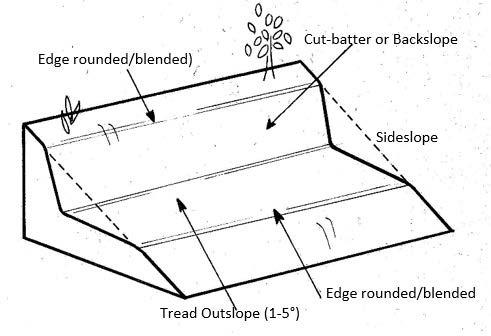
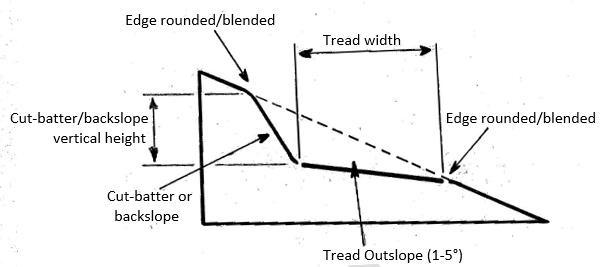

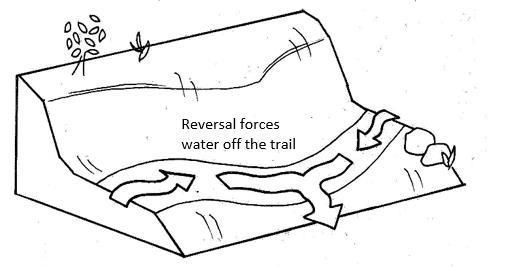 Figure 1 Trail Cross Section
Figure 2 Gradient Measurement (For section of trail)
Figure 1 Trail Cross Section
Figure 2 Gradient Measurement (For section of trail)
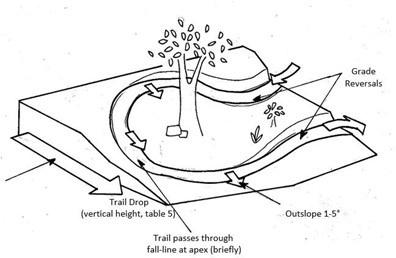
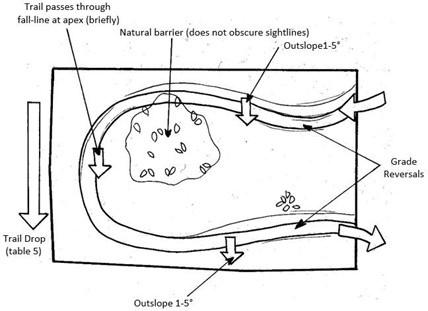

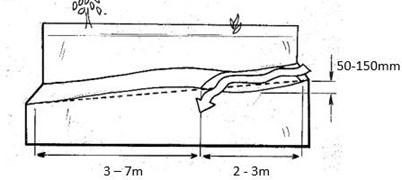

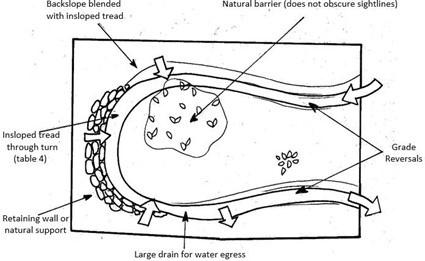
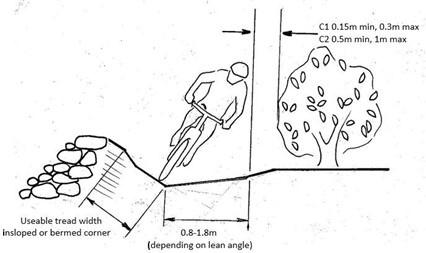
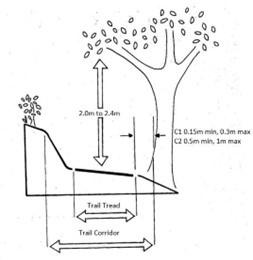
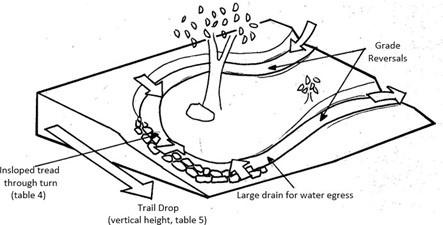

Based on first edition 2018
Second Edition August 2022
• Title of document changed from 'Guidelines' to 'Specifications'
• NZ Grading colour added
• Amended guidance on potential for a fall from height, and reference to guardrail/barriers information
• Amended heading for Uphill Trails, to Uphill and/or Two-way Trails
• Introduction of User Experience
• Introduction of backslope or cut batter guidance
• Introduction of non-discernible width for G4 and above
• Amended heading: Target Gradient average changed to Average Gradient (end to end max)
• Introduction of 'Exceptions (key component tolerance)' to uphill and descending trails - includes tighter corners and narrow trail to the existing steeper gradients
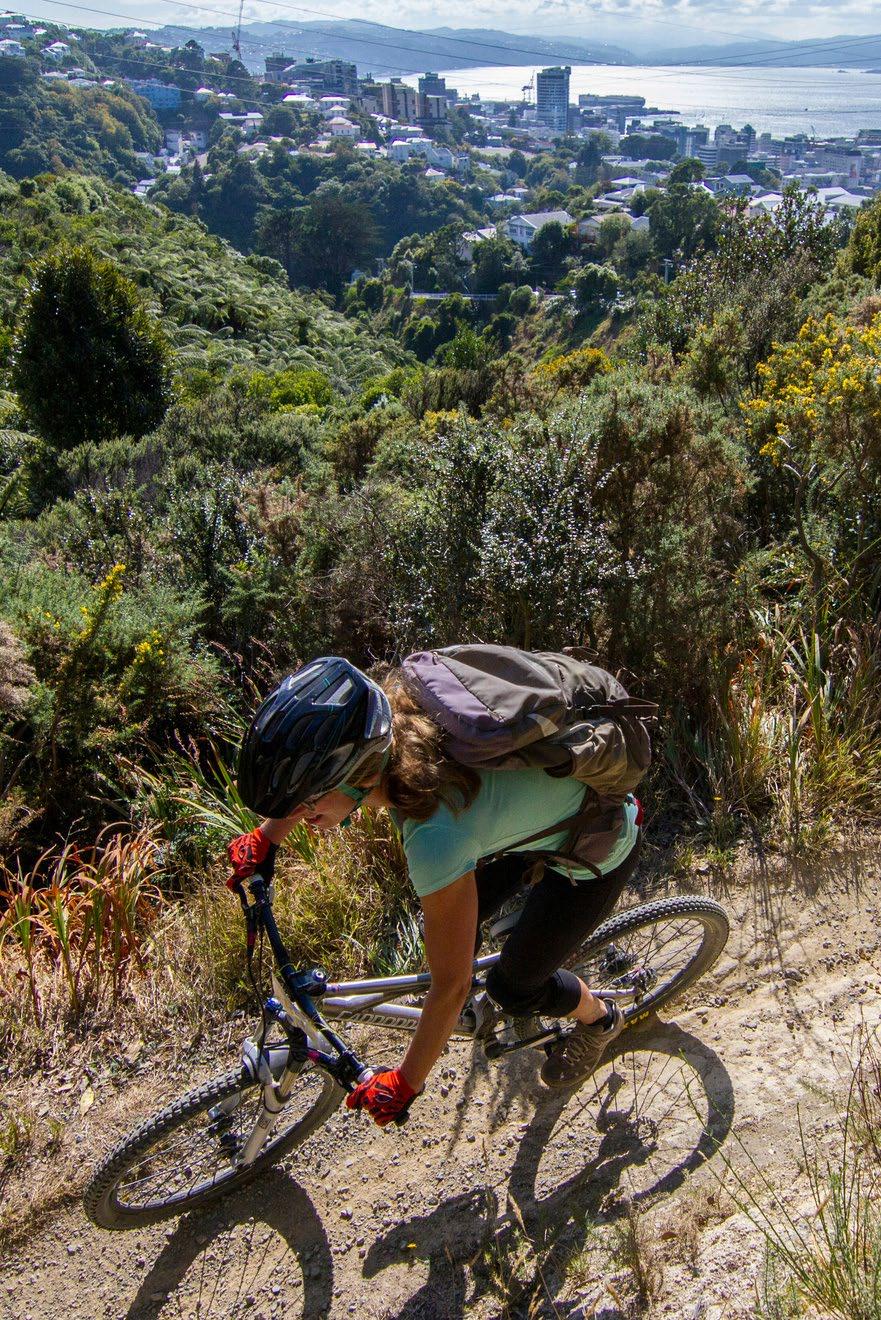
• Introduction of guidance for 'only one grade harder' to support above point
• Introduced Average Gradient guidance on how to calculate this
• Expanded heading Maximum Gradient with (sections of trail) for clarity
• Amended Technical Trail Features to be clearer, including a lesser stepped drop height progression
• Amended Tread Obstacles to clarify what they are, and include heights for G4-6
• Amended Trail Surface for commonly available aggregate sizes
• Introduction of eMTB information
• Introduction of aMTB information, aligning with NZ grading system
• Amended Clearance to, to include measurement from top of trail features
• Amended Additional Clearances to include proximity information
• Amended Environmental Considerations to include other contaminants
• Amended Trail Type to include the addition of 'aMTB' where appropriate
• Amended Table l to make it clear the DOC correlation between DOC visitor/user groups and Trail Grading has been utilised with this information
• Introduction of Fig 1-7 diagrams and drawings for key principles
• Introduction of Table 6 Jump Design Guidance
• Introduction of gradient comparison/relationship table
• Introduction of 'Entry Barriers' information (accessibility)